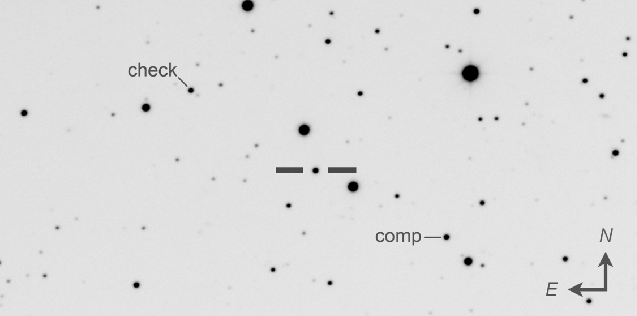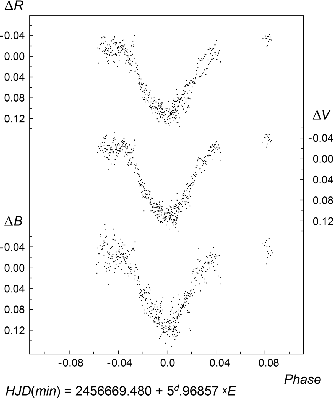|
Peremennye Zvezdy (Variable Stars) 37, No. 3, 2017 Received 28 September; accepted 12 October.
|
Article in PDF |
A photometric study of GSC 01374-01131, a HADS variable star with an eclipsing component
A. V. Khruslov1,2, R. I. Kokumbaeva3, A. V. Kusakin3, I. V. Reva3
![]() Sternberg Astronomical Institute, Moscow State
University, Universitetsky pr. 13, 119992, Moscow, Russia; e-mail:
khruslov@bk.ru
Sternberg Astronomical Institute, Moscow State
University, Universitetsky pr. 13, 119992, Moscow, Russia; e-mail:
khruslov@bk.ru
![]() Institute of Astronomy, Russian Academy of Sciences,
Pyatnitskaya Str. 48, 119017, Moscow, Russia
Institute of Astronomy, Russian Academy of Sciences,
Pyatnitskaya Str. 48, 119017, Moscow, Russia
![]() Fesenkov Astrophysical Institute, Observatory 23,
050020, Almaty, Kazakhstan; e-mail: un7gbd@gmail.com
Fesenkov Astrophysical Institute, Observatory 23,
050020, Almaty, Kazakhstan; e-mail: un7gbd@gmail.com
|
We present the results of our new observations of GSC
01374-01131, a recently discovered high-amplitude |
1. Introduction
The variability of GSC 01374-01131 = VSX J074722.4+220414 (RA =In 2013, one of the authors of the present paper (A.V. Khruslov) reinvestigated the star using the publicly available data of the Catalina Surveys2(Drake et al. 2009). According to his publication (Khruslov 2013), the variable is a HADS star with an eclipsing component (EA or EB type). The light elements of the pulsating and eclipsing components of the light variations are the following:
2. Observations and data reductions
We acquired new photometry of GSC 01374-01131. Our CCD observations in the standard Johnson
Our observations were performed with one of the two observatory's
Zeiss 1000-mm reflectors, the "eastern Zeiss" (the focal length
of the system was ![]() mm before JD 2456500 and 6650 mm
after this date; the detector was an Apogee U9000 D9 CCD camera).
mm before JD 2456500 and 6650 mm
after this date; the detector was an Apogee U9000 D9 CCD camera).
The finding chart (Fig. 1) identifies the variable star,
comparison star, and check star. Information on the comparison
star and check star used in our CCD photometry is presented in
Table 1. The magnitudes of the comparison star are from the AAVSO
Photometric All-Sky Survey
(APASS3)
catalog. The ![]() -band observations could be presented only as
magnitude differences with respect to the comparison star (
-band observations could be presented only as
magnitude differences with respect to the comparison star (
![]() ).
).
| Comparison star | Name | GSC 01374-01123 |
| Coordinates, J2000.0 |
|
|
| 14 |
||
| 14 |
||
| Check star | Name | GSC 01374-01674 |
| Coordinates, J2000.0 |
|
Reductions were performed using the MaxIm DL Version 5.23 aperture photometry package. We analyzed the time series using two methods implemented in the WinEfk code4 written by V.P. Goranskij: the Deeming method (Deeming 1975) for the pulsating component and the Lafler-Kinman method (Lafler & Kinman 1965) for the eclipsing component. The Deeming method is used for data analysis in the case of sinusoidal light curves and search for multiperiodic variability. The Lafler-Kinman method is much more suitable for data analysis in the case of variables with strongly asymmetrical light curves (for example, RRab stars and eclipsing binaries, especially Algol-type variables).
Our observations are provided online in the html version of this paper.
In addition, we used new Catalina Surveys data, recently made available to users, to improve the light elements.
3. Results
We improved the periods of eclipses and pulsations and other parameters of the light curves. GSC 01374-01131 is an eclipsing binary of the Algol type (EA); one of its components is a pulsating HADS star (DSCT+EA according to classification of the General Catalogue of Variable stars, GCVS5, Samus et al. 2017). The new light elements of the pulsating and eclipsing components of the light variations are the following:
The light curves of GSC 01374-01131 from raw CCD data with the two
periods are displayed in Fig. 2. The light curves with the
eclipsing variations pre-whitened, folded with the pulsation
period, are presented in Fig. 3. The light curves with the
pulsations pre-whitened, folded with the eclipsing period, are
shown in Fig. 4. All light curves are given in the Johnson ![]() ,
,
![]() , and
, and ![]() bands. The primary minimum (with the pulsations
pre-whitened) is displayed in Fig. 5.
bands. The primary minimum (with the pulsations
pre-whitened) is displayed in Fig. 5.
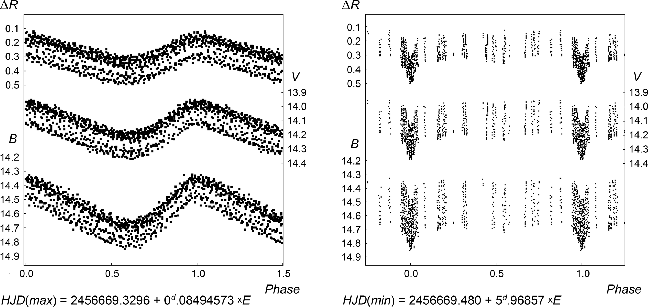 |
Fig. 2. The light curves of GSC 01374-01131 from raw CCD data, folded with the periods of pulsations (left) and eclipses (right). |
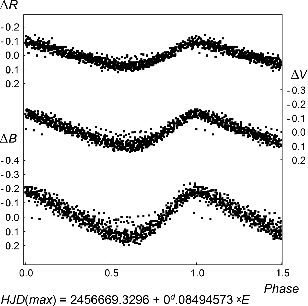 |
Fig. 3. The light curves of GSC 01374-01131 with the eclipsing variations pre-whitened, folded with the pulsation period. |
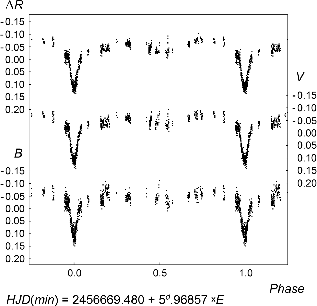 |
Fig. 4. The light curves of GSC 01374-01131 with the pulsations pre-whitened, folded with the eclipsing period. |
We derived new light elements taking into account the newly available CSS data (time interval JD 2453469 - 2457495). The light curves of GSC 01374-01131 with the other variation pre-whitened, from Catalina Surveys data (CSS), are presented in Fig. 6.
 |
Fig. 6. The light curves of GSC 01374-01131 from CSS data folded with the pulsation period (left) and eclipsing period (right), with the other variation pre-whitened. |
The light curve shape of the eclipsing variation component is of
the Algol type. The duration of primary eclipse is
![]() . The depth of the primary eclipse is the same in
all photometric bands. There is a slight decrease in the
brightness level at the phase 0.5 (secondary minimum). The
brightness level outside the eclipses varies a little (most
noticeably, in the
. The depth of the primary eclipse is the same in
all photometric bands. There is a slight decrease in the
brightness level at the phase 0.5 (secondary minimum). The
brightness level outside the eclipses varies a little (most
noticeably, in the ![]() band), a kind of O'Connell effect. The
amplitude (depth) of the primary eclipse is comparable to the
amplitude of pulsations. Among all currently known HADS stars in
Algol-type eclipsing binary systems (HADS+EA in the AAVSO
classification), GSC 01374-01131 has the lowest amplitude of the
eclipse.
band), a kind of O'Connell effect. The
amplitude (depth) of the primary eclipse is comparable to the
amplitude of pulsations. Among all currently known HADS stars in
Algol-type eclipsing binary systems (HADS+EA in the AAVSO
classification), GSC 01374-01131 has the lowest amplitude of the
eclipse.
In observations of a binary system, we measure total (combined)
light from a point source; actually, the full amplitude of light
variations of the pulsating component should be significantly
larger, in full accordance with the HADS type. The asymmetry
parameter of the pulsation light curve is
![]() .
.
The amplitudes of pulsations and eclipses, depths of the primary
minimum, and ranges of light variations for the Johnson ![]() ,
, ![]() ,
and
,
and ![]() bands and for the Catalina Surveys
bands and for the Catalina Surveys ![]() band are
presented in Table 2.
band are
presented in Table 2.
| Band | Semi-amplitude, | Full amplitude, | Depth of | mag |
| pulsations, mag. | eclipses, mag. | Min I | ||
| 0.1489 | 0.17 | 0.14 |
|
|
| 0.1052 | 0.18 | 0.14 |
|
|
| 0.0771 | 0.19 | 0.13 |
|
|
| 0.0760 | 0.18 | 0.12 |
|
![]() For the
For the ![]() band, the total variability amplitude is given.
band, the total variability amplitude is given.
Acknowledgments: The authors are grateful to Dr. V.P.
Goranskij for providing light-curve analysis software. Thanks are
due to Dr. N.N. Samus for helpful discussions. We wish to thank
M.A. Krugov, N.V. Lichkanovsky, and I.V. Rudakov for their
assistance during the observations. This study was supported by
the Basic Research Program P-7 of the Presidium of Russian
Academy of Sciences and by the Science Committee of the Science
and Education Ministry of Kazakhstan (project No. 0075/GF4).
References:
Deeming, T. J., 1975, Ap&SS, 36, 137
Drake, A.J., Djorgovski, S.G., Mahabal, A., et al., 2009, Astrophys. J., 696, 870
Khruslov, A.V., 2013, Perem. Zvezdy, 33, 1
Lafler, J., Kinman, T. D., 1965, Astrophys. J. Suppl., 11, 216
Samus, N. N., Kazarovets, E. V., Durlevich, O. V., Kireeva, N. N., Pastukhova, E. N., 2017, Astron. Rep., 61, 80
